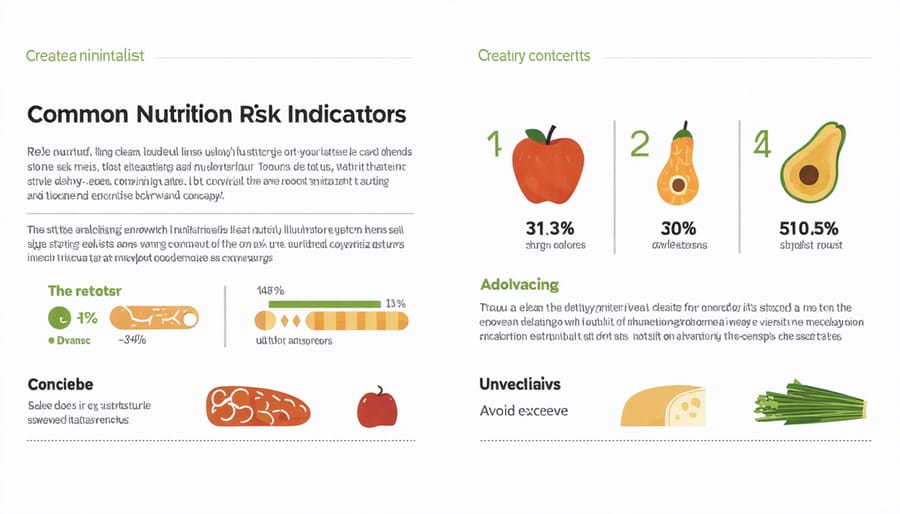Understand WIC nutrition risk criteria to access essential support for mothers and young children in Alberta. These evidence-based guidelines help identify individuals who may benefit from supplemental foods, nutrition education, and healthcare referrals. Medical professionals evaluate risks across four key categories: anthropometric (weight-related), biochemical (blood tests), clinical/health (medical conditions), and dietary. Common qualifying factors include pregnancy complications, inadequate prenatal care, chronic health conditions, and poor nutrition practices. Early screening through WIC’s comprehensive assessment process ensures vulnerable populations receive timely intervention and support to improve maternal and child health outcomes. Healthcare providers and social workers use these standardized criteria to make objective eligibility determinations while maintaining dignity and respect for program applicants.
This introduction provides essential context while maintaining an accessible tone, avoiding medical jargon, and emphasizing the supportive nature of WIC services for the target audience in Alberta.

Understanding WIC Nutrition Risk Categories
Health-Based Risks
Several health conditions can qualify individuals for WIC support, particularly those affecting pregnant women, new mothers, infants, and young children. Common qualifying conditions include anemia, underweight status, and gestational diabetes during pregnancy. For infants and children, failure to thrive, low birth weight, and nutritional deficiencies are significant risk factors that warrant WIC assistance.
Mothers experiencing postpartum complications or those with a history of high-risk pregnancies may also qualify. Other health-based risks include food allergies, celiac disease, and metabolic disorders that require special dietary considerations. Recent illness or medical conditions that impact nutritional status, such as gastrointestinal problems or dental issues affecting eating ability, are also considered.
Mental health conditions that affect eating patterns or nutritional intake may qualify as nutrition risks. Additionally, conditions that require increased nutritional support, such as recovery from surgery or chronic illnesses, are evaluated during the WIC screening process.
It’s important to note that these health conditions must be documented by a healthcare provider. Regular check-ups and monitoring help ensure participants receive appropriate nutrition support tailored to their specific health needs.
Dietary Risks
Dietary risks in WIC assessments focus on eating patterns and nutritional choices that may impact health outcomes. Common concerns include inadequate fruit and vegetable intake, excessive consumption of sugar-sweetened beverages, and irregular meal patterns. Developing a personalized nutrition plan can help address these risks effectively.
Key dietary risk indicators include:
– Skipping meals regularly, especially breakfast
– Relying heavily on processed convenience foods
– Limited variety in food choices
– Inadequate protein or iron-rich food consumption
– Excessive intake of foods high in sodium or saturated fats
– Poor hydration habits
– Restrictive eating patterns
For Alberta families, these risks often stem from various factors such as busy schedules, limited food preparation knowledge, or budget constraints. Understanding these patterns helps healthcare providers offer targeted support and practical solutions. Simple changes, like incorporating more whole grains, planning balanced meals, and choosing nutrient-dense snacks, can significantly improve nutritional status.
Working with local nutritionists and community resources can provide valuable guidance in developing healthier eating habits while respecting individual circumstances and cultural preferences.
Key Nutritional Risk Factors in Alberta
Income-Related Food Insecurity
Income-related food insecurity significantly impacts nutritional health and is a key consideration in WIC eligibility. When families struggle to afford nutritious food, they’re more likely to experience common nutritional deficiencies and face challenges maintaining a balanced diet. In Alberta, many families find themselves choosing between paying bills and purchasing healthy food options, which can lead to compromised nutrition.
Food insecurity often results in relying on less expensive, calorie-dense foods that may lack essential nutrients. This can particularly affect pregnant women, infants, and young children – the primary groups WIC aims to support. The program considers household income, family size, and access to nutritious food when determining nutrition risk.
Local food banks and community resources work alongside WIC to provide additional support. Families experiencing income-related food insecurity may qualify for multiple assistance programs, creating a stronger support network. Understanding these connections helps ensure eligible families receive comprehensive nutritional support during crucial developmental periods.

Cultural and Geographic Considerations
Cultural and dietary practices vary significantly across Alberta’s diverse communities, presenting unique challenges in meeting WIC nutrition criteria. Vulnerable populations in Alberta, including Indigenous communities, new immigrants, and rural residents, often face distinct nutritional barriers.
Geographic location plays a crucial role in food accessibility. Rural and remote communities may have limited access to fresh produce and nutritious foods, particularly during harsh winter months. This can impact their ability to meet WIC nutritional requirements and maintain a balanced diet.
Cultural food preferences and traditional dietary practices must be considered when assessing nutrition risk. For instance, some communities may follow specific dietary restrictions or have traditional food preparation methods that influence their nutritional intake. WIC programs in Alberta work to accommodate these cultural differences while ensuring nutritional adequacy.
Language barriers and cultural beliefs about health and nutrition can also affect how families understand and implement dietary recommendations. Local WIC offices provide culturally sensitive guidance and resources in multiple languages to support diverse communities in meeting their nutritional needs.
Practical Steps to Address Nutrition Risks
Local Resources and Support
Alberta offers several valuable resources for families needing nutritional support. Alberta Health Services provides free nutrition counseling through their Healthy Beginnings program, available at local health centers across the province. The Parent Link Centers, found in major cities like Edmonton and Calgary, offer additional support services and educational workshops about healthy eating.
For immediate assistance, call Health Link at 811 to connect with a registered dietitian. The Alberta Food Bank Network also partners with local organizations to provide emergency food support. Many community health centers offer specialized programs for pregnant women and young children, including breastfeeding support groups and cooking classes.
Remember to contact your nearest public health unit to learn about specific programs in your area. Most services are free or low-cost, and many offer flexible scheduling to accommodate working families.

Understanding WIC nutrition risk criteria is crucial for accessing the support and resources available through this vital program. By recognizing the various risk factors – from medical conditions to dietary concerns – families can better advocate for their needs and ensure they receive appropriate assistance. Remember that these criteria aren’t barriers but rather tools to identify where support is most needed.
If you think you might qualify for WIC benefits, don’t hesitate to reach out to your local Alberta Health Services office or community health centre. Healthcare providers and WIC staff are ready to help evaluate your situation and guide you through the assessment process. The sooner you connect with these resources, the sooner you can access nutritional support for yourself and your family.
Take the first step today by scheduling an appointment for a nutrition assessment. Every family deserves access to proper nutrition and healthcare support. Your well-being matters, and there are dedicated professionals in your community ready to help you navigate the WIC program and its benefits.

